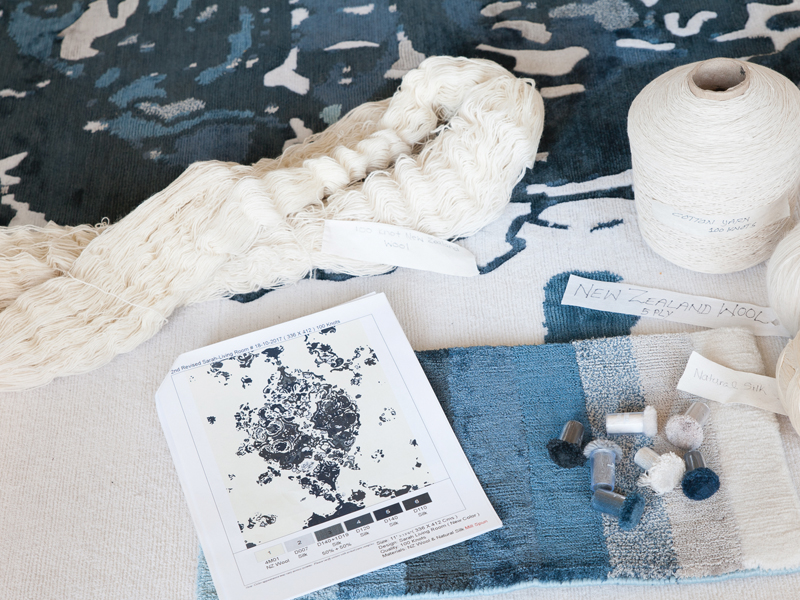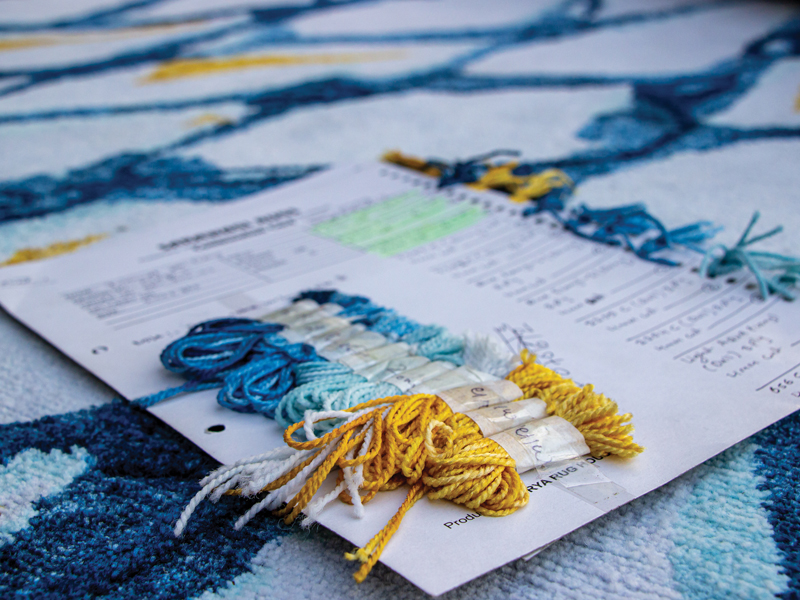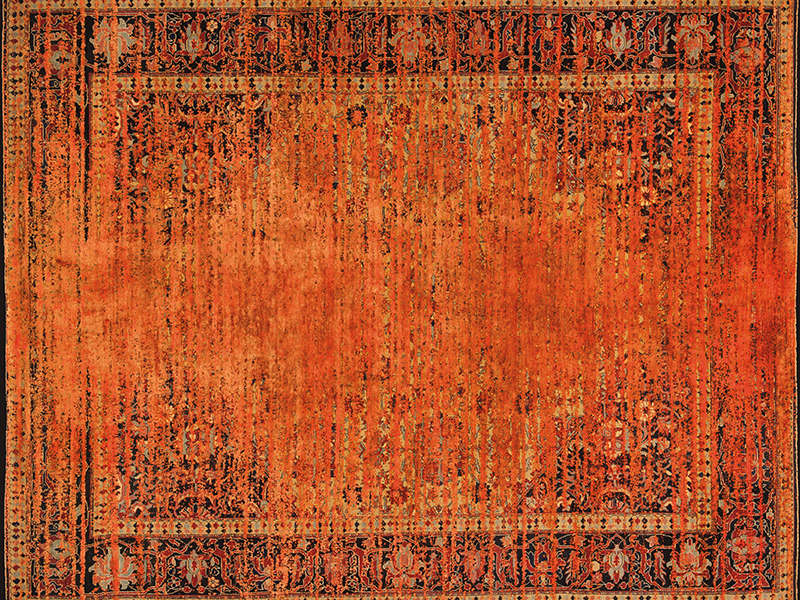In the summer 2018 issue of RUG INSIDER Magazine we featured “The Rugs and Carpets of Fallingwater"—an exploration of the carpets which grace the floors of the renowned architectural masterpiece. Throughout that issue we also chronicled carpets in tune with David Bowie’s classic “Modern Love,” and offered a furtive look at the oft-copied Scandinavian aesthetic of Märta Måås-Fjetterström. Likewise, friend of RUG INSIDER Alicia Keshishian shared her opinions in “(Re)defining a Style” as we discussed the perennial “mid-century modern” aesthetic enjoying a resurgent popularity.
In doing so, we explored colloquial uses of the term “modern” without delving into the true meaning of the term or what it means to make a modern carpet, embracing modernity —as we must—to its fullest. As Keshishian remarked then, “Everything is modern its time.” Now, as the euphemistically optimistic “new normal” settles in, we’re left asking “What is a modern carpet?”
Without hesitation the first consideration that must be taken into account is, as Keshishian noted, the times in which we live. Pandemic or otherwise, the concept of modernity—and the visual styles named thereafter—is inextricably tied to the time in which the rug or carpet was made.
In short, everything—including carpets which we might afford higher or lesser stature and made in the past, say, 40 years—has been part of the “modern carpet revolution” regardless of method of construction, materials, visual design, texture, and so on. If it was newly made, it was indeed modern. Now, one such as myself has argued, often forcefully, that hand-knotted—especially certain dear qualities—is the epitome of the craft, but this cannot be to say that only those carpets are superior or somehow more authentically modern. I now view this as a mistake on my part. Not because the carpets I love weren’t modern, but rather I failed to see the entirety of the tableau through different perspectives.

Michael Christie, Editor of RUG INSIDER Magazine and “The Ruggist” shown among his favorite genre of hand-knotted carpet, Nepali-Tibetan, which he now begrudgingly admits is no longer the epitome of modern he once thought it was.
This includes the fact that many motifs attributed as modern are only apparently so, owing to time and newfound exposure. Of course something the casual viewer has never seen before appears modern and of this time, for it lacks historic and ethnographic perspective.
In the 20th century and up though, say, the 1980s, 1990s, and the oughts of this century this was relatively easy to accomplish due to more limited flow of information. In 2020 information is veritably limitless, and so to present a carpet design that marvels as those of the past have is, I now argue, increasingly difficult. Everything modern we produce is somehow derivative, influenced, or reminiscent of something else. This is explored in more detail in the companion article Interwoven Authenticity: A Bona Fide Essay on the Faithful, which also appeared in our fall 2020 issue.
Moreover, to euphemistically “borrow” the designs of one culture to create hand-knotted carpets in the context of the global rug trade seems as though one runs the risk of cultural appropriation. While I might suggest it is all human culture, the argument that taking the work of one group and presenting it as one’s own sounds oddly similar to arguments surrounding issues of copyright and the like.
So what is a modern carpet of 2020? It is one that not only honors the disparate traditions of craft and carpetry, but also does so by respecting the current and emerging cultural zeitgeist through consideration and utilization of the technology and materials of today. To be truly modern, a carpet must appeal to those woke sensibilities often lamented by waning generational cohorts.
But being of this time requires us to not solely be of a pandemic-plagued society but to attempt to divine the future needs of emerging generational cohorts; for too long, short-term gains have outweighed long-term goals. Thus, it seems to me that a modern carpet of today must incorporate the needs of the future. And those are certainly different from now, or say even twelve months ago.
Modern Sensibilities
Acknowledging this is a highly simplified view of design, we must also acknowledge that the use of “modern” in the common vernacular of interior design is vaguely defined at best. Just as is “traditional” and without doubt, “transitional.” Aesthetics cast aside, a modern carpet should embody simply one thing: it should reflect all we know about materials, craft, economy, labor, et alia which embodies the absolute best wisdom derived thereof. At, and of this time. It means questioning what we’ve done because of tradition, just as it means questioning all aspects of carpetry including newfound materials and techniques to ensure they are sympathetic to the needs of this time and the future.
To highlight with hyperbolic intention, imagine it as #blacklivesmatter meets income inequality meets the information age meets the climate catastrophe all within the context of the Anthropocene. In the interest of expedience and illustration, only three of myriad concerns are considered herein: technological, social, and environmental.
The Information Age
Everything about carpetry is technology and as such the argument against “technology” in carpetry is hereby summarily dismissed as puerile and sophomoric. A modern carpet can be hand-knotted just as it can be machine-made, for both of these exist now due to the sum technology of this time. Likewise, sales and distribution must now incorporate technology and leverage it to meet the needs and wants of consumers.
Similarly, we now have immense scientific and technical resources at our disposal which allows us to know—if we take the time to ask—the impact these modern carpets will have on the latter two concerns: social and environmental. No longer is it simply enough to anecdotally claim a hand-knotted carpet made with dyed all-natural materials is the most environmentally sound. We have the technology to prove this, and prove or disprove this we must if we are to truly embrace modern technology.

As featured in both the Summer and Fall 2019 issues of RUG INSIDER, the work of Toronto’s Weaver and Loom combines modern technology, including all the ease of use it brings, social and environmental concerns, and ancient craft to produce carpets worthy of this era. Photograph courtesy of Weaver and Loom.
A New Social Paradigm
Whether or not one agrees with the civic unrest in the United States and beyond, the analytic mind offers but one conclusion: clearly the system, such that it is, is not working for everyone and therefor must change. For students of history this sounds strikingly familiar, for it is. And just like before, change will come and take what we know and turn it on end. And just like in the past, this new cycle will repeat.
As laid bare as an aside, The Truth We Do Not Speak (at the close of this article), the making and distribution of hand-knotted rugs and carpets is fraught with inequity. I believe the social media technology of today has and will allow this to become more and more apparent until there is a breaking point. It seems that prudent carpet firms would work to address all levels of social concerns in advance of potentially catastrophic backlash.
Environmentally Speaking
Thirdly, we must stop producing rugs and carpets that are not environmentally sound. What does this mean? Certainly it includes the aforementioned use of technology to accurately gauge the impact of a carpet. It also means acknowledging that there is no one way of doing this. A truly modern rug or carpet must be crafted according to the principles of circular design so that from cradle to grave there is not only a plan for the carpet, but there is one that does not involve the landfill.
For example, most tufted and machine-made rugs, those crafted of so-called up-cycled materials, as well as those made of materials which cannot be recycled or composted, need to be phased out of the marketplace. Quickly. This is emphatically not to say the industry should abandon lower price point wares; far from it. However, it is to say that these wares must be redesigned so that at their end of use, they can be broken apart into their constituent components and returned to the earth or to manufacturing for circular reuse. This is the central premise of nature itself—everything in a loop—and a luxury ware such as any rug or carpet, in fact any non-essential or non-lifesaving item, should conform to this standard.
Conclusion
I know not the answers to many of the questions and issues raised in this essay. I do know—from my years of listening to rug dealers, rug importers, marketers, consumers, the news, et alia—that mistakes have and are still being made, perhaps only because we fail to address the underlying issues. We’re defensive instead of offensive. We’re reactionary instead of progressive. We’re treating the symptoms but not the cause. And most of all, we treat business as the goal rather than beautifying and improving the lives of those involved in all levels of rug and carpet manufacture.
“Now, one such as myself has argued, often forcefully, that hand-knotted—especially certain dear qualities—is the epitome of the craft, but this cannot be to say that only those carpets are superior or somehow more authentically modern.“
For as much as we rightfully laud the amazing rugs and carpets of the past, we often fail to extrapolate from this admiration the reasons why. Let us proactively ask the impossible question, “What will a future rug aficionado and consumer admire and require?” Or, the more easily answered, “How can we make these in a socially, ecologically, and technologically sound way?” Only then setting out to craft a modern carpet, one decidedly of and for the 21st century.

A detail image showing Nylon Engulfed, the first hand-knotted carpet made of ECONYL® regenerated nylon. As prototype the carpet explores the use of a novel circularly regenerable synthetic fiber in the realm of handcrafted carpets. Designed by Isobel Morris and made by Sarawagi Rugs of Kathmandu, Nepal the carpet represents new thinking by young designers.
The Truth We Do Not Speak
“When passion is a privilege, authenticity and truth become the options of those at an advantage.“
These are the astute and poignant words shared directly with me by a carpet maker from Bhadohi, Uttar Pradesh, India. Known as “The Carpet City,” Bhadohi is the largest handmade rug and carpet weaving and manufacturing centre in Asia, and therefore globally. It is also desperately poor in ways that Westerners typically cannot even begin to fathom. These two things—carpet making and poverty—have been, and generally remain, inextricably interconnected with the former, all but dependent upon the latter. At least within the confines of hand-knotted, handwoven, and other manually-intensive forms of carpet making. This is the unfortunate and oft unspoken nature of carpetry—modern-day or otherwise.
Bold as this may seem to commit this thought to written word, it is not as if this is a sudden revelation, some newfound insight, nor is it a recent development. This exploitation of the worker in favor of the capitalist is well studied and documented throughout the course of human history and manufacturing. Marx wrote of the dangers thereof in “Das Kapital,” and innumerable conflicts have been fought by those who would demand fair, equal, or as it should be, equitable treatment. At its worst this exploitation has brought chattel slavery to humanity. At its best it has allowed for the advancement of civilization to its current state of simultaneous extravagance of wealth contrasted with the abject poverty upon which the indulgent is often based. Depending on one’s place in said contemporary zenith, the use of “best” can be and is rightly described as elitist, or classist, or privileged—again, at best. At worst, oppressive, exploitive, colonialist, perhaps even racist, and so forth.
These are not falsehoods, nor is this author using hyperbole or exaggeration to explain the real world situation as it truly is. The unvarnished nature of this language reveals—as those who have long struggled against oppression have known—the truth of the matter: perspective, ignorance, and naïveté—willful, inadvertent, systemic, or otherwise—affect our worldview. For someone whose career, such that it is, was built upon the successes of the fin de millénaire modern carpet revolution, the place from which I write, one which extols fanciful and romanticized, if not also fetishized, concepts of craft and labor, is indeed one of privileged elitism. This is the nature of this author’s passion for authentic and true hand-knotted rugs and carpets and it provides for an advantage unimaginable to so many. Simultaneously, it remains a place of disadvantage compared and in relation to—for in this discussion all things are relative—those even more privileged demographics who purchase said rugs and carpets.
How this advantage has been used, for it always is wielded, and more importantly how it should be, is the basis of this essay on modernity. When Western rug and carpet traders and designers publicly speak of their trade, there is much focus on tradition, craft, art, handwork, authenticity, preservation, et cetera and so forth and make no mistake these concepts are true to a degree. However, unless the hand-knotted rug and carpet industry embraces modernity, empathy, and the sum of human intelligence at our disposal, then it will remain a dying anachronism out of sync with the zeitgeist of the early 21st century. But it need not be this way.
Just as the #blacklivesmatter movement has once again made raw and impossible to ignore the injustices perpetuated against minorities in the United States and beyond, so too does this leitmotif likewise require of the rug and carpet trade an interrogation of the roles race, poverty, power and the like have and continue to play in the industry. Why (k)not embrace the immense opportunities of change in order to craft a modern carpet industry?
As Leslie Stroh, Publisher of Rug News and Design stated in a recent Zoom conference organized by the KCEC, “Let’s face it. The rug industry is one in which rich women buy rugs made by poor women.” While I would consider polishing this for the more inclusive audiences as “rich consumers” and “impoverished workers” the sentiment is nevertheless welcomed commentary.
Michael Christie
